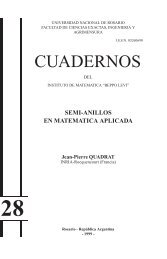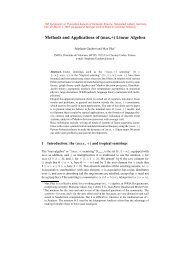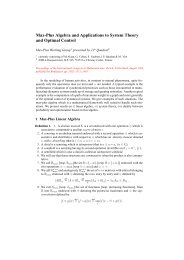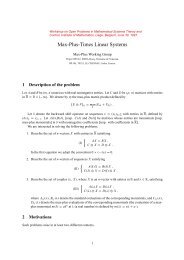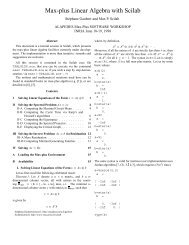Leta ∗ := e ⊕ a ⊕ a 2 ⊕··· (32)Interesting, and easy to check, properties of this star operation areLet also a + := a ⊗ a ∗ and notice thatTheorem 9(i) a ∗ b is the least solution of (31).(a ∗ ) p = a ∗ , ∀p ∈ N and (a ∗ ) ∗ = a ∗ (33)(ii) For all solution x, one has that x = a ∗ x.Proofa ∗ = e ⊕ a + and a ∗ ≥ a + (34)(i) Clearly, if x is a solution, x ≥ b and x ≥ ax. On the one hand, a p x ≥a p b. On the other hand, x ≥ ax ≥ ... ≥ a p x. Hence, x ≥ a p b,thusx ≥ ⊕ ∞p=0 ap b = a ∗ b. Finally, it is straightforward to check that a ∗ b is alsoa solution.(ii) From (31), one gets that x = a(ax ⊕ b) ⊕ b = ...= a p x ⊕ (e ⊕···⊕a p−1 )bfor all p. Summing up all these equalities for p ∈ N yields x = a ∗ x ⊕ a ∗ b.But from (i) above, a ∗ x ≥ a ∗ b or a ∗ x ⊕ a ∗ b = a ∗ x which completes theproof.□Theorem 9 answers the issue of existence of solutions to (31) in complete dioids.About uniqueness, we observe that if the homogeneous equationx = ax (35)has a solution y ≠ ε, yz is also a solution of (35), ∀z ∈D, and obviously a ∗ b⊕yzis a solution of the nonhomogeneous equation (31). In usual linear algebra, it iswell known that all solutions of the nonhomogeneous equation are obtained byadding all solutions of the homogeneous equation to a particular solution of thenonhomogeneous. Here, for such a result to hold true, the “particular solution”has to be the least one (namely a ∗ b) because “adding” also means “increasing”.Theorem 10 Let D be a distributive dioid. Then, if x is a solution of (31), itcan be written as x = y ⊕ a ∗ b where y is a solution of (35).Proof For any given solution x of (31), we consider the subset C x := {c | x =c ⊕ a ∗ b}. Ifc ∈C x , then ac ∈C x too. As a matter of fact, x = c ⊕ a ∗ b ⇒ ax =ac ⊕ a + b ⇒ x = ax ⊕ b = ac ⊕ a ∗ b from the equality in (34). Also, if c, d ∈C x ,then c ⊕ d ∈ C x since x = x ⊕ x = c ⊕ d ⊕ a ∗ b. Therefore, if c ∈C x , then a ∗ c ∈C xtoo.14
Let now z := ∧ c∈C xc. Since D is distributive, z ⊕ a ∗ b = ∧ c∈C x(c ⊕ a ∗ b)=x,which means that z ∈C x . Hence, az ∈C x too. From the very definition of z, itfollows that z ≤ az and thus a ∗ z ≤ a + z. But the inequality in (34) shows thatindeed y = ay if we set y := a ∗ z. To complete the proof, notice that y ∈C x ,asobserved earlier.□3.5 The homogeneous equation x = axIt is possible to characterize all solutions of (35) in the situations described byTheorems 11 and 12 hereafter. Let us first introduce a new notation for aninvertible a, that is when there exists a −1 such that a ⊗ a −1 = a −1 ⊗ a = e.a # := a ∗ ⊗ (a −1 ) ∗ =(a ⊕ a −1 ) ∗ = a ∗ ⊕ (a −1 ) ∗ (36)These equalities can be checked easily as the following additional propertiesa ⊗ a # = a ∗ ⊗ a # = a # (37)Theorem 11 (Scalar case) Consider Equation (35) with a, x ∈D, where Dis a distributive and commutative dioid. Moreover, it is assumed that a can bewritten as a finite sum of invertible elements {a k | k =1,...,p}. Then, anysolution x of (35) is of the formx =p⊕a # k y ka ∗ (38)k=1where the y k ’s are arbitrary elements of D.Proof The proof is by induction on the integer p. For p =1,ifx = ax, thenx = a ∗ x, but also x = a −1 x,thusx =(a −1 ) ∗ x, and finally x = a # x. Conversely,if x = a # y for any y, from (37) it follows that x = ax. Notice that sincea # = a # a ∗ , the theorem is proved for p =1.Assume that the statement of the theorem is true up to some value p − 1. Ifx =(a p ⊕ b)x where b = ⊕ p−1k=1 a k, from Theorem 9-(ii), one has that x = a ∗ px.Now, using Theorem 10 and this Theorem 11 for p = 1 (already proved), onehas that x = a ∗ bx ⊕ a # p y p for some y p ∈D. Using commutativity and the factthat x = a ∗ px, one gets that x = bx ⊕ a # p y p . Again using Theorem 10 and theinduction assumption, one concludes that x = b ∗ a # p y p ⊕ ( ⊕ p−1k=1 a# k y kb ∗ ) for somey k ’s. The desired formula (38) is obtained by multiplying this last equality bya ∗ p, by remembering that x = a ∗ px, and by noticing that a ∗ = a ∗ pb ∗ from formula(49) established independently later on.Conversely, if x is given by (38), we must show that x = ax. Actually, itsuffices to prove this for any x corresponding to all y k null, except one, say y itaken equal to e, since then, by linearity, the statement will hold true for alllinear combinations of such x’s. If x = a # i a∗ , then ax = a # i a+ ≤ x from (34).15



